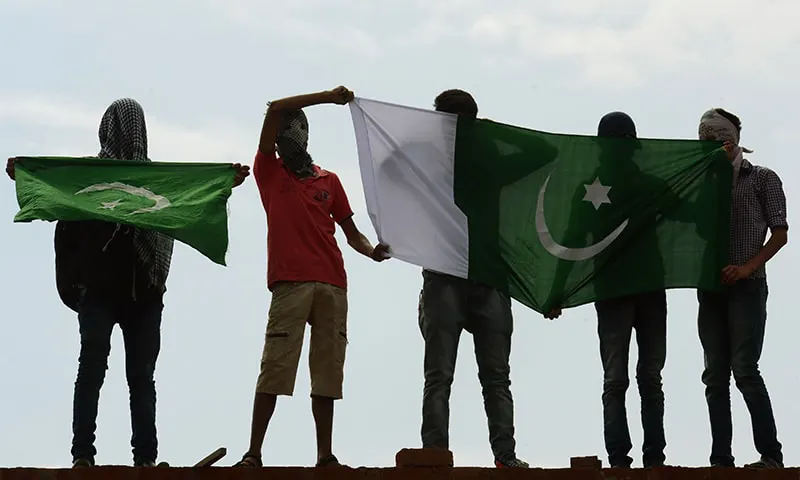Nayeem Maqbool
The logic behind the partition of the Indian Empire into Muslim and non-Muslim portions suggested that Jammu Kashmir ought to go to Pakistan. The Princely State with a predominantly Muslim population under a Hindu Maharaja was so situated geographically that it was more a part of Pakistan than India.
The Jammu and Kashmir dispute dates back to the era of decolonization and transfer of power by British. During the partition of Indian sub-continent the principle of “communal majority” was adopted, i.e. the contiguous Muslim majority were assigned to Pakistan while as Hindu majority areas were assigned to India. This partition plan as such didn’t apply to 565 princely states that enjoyed semi-autonomous status under the British rule. Later these princely states became legally and completely independent after the end of the British rule on 15 august in 1947. These princely states were under no obligation either to join India or Pakistan. The then viceroy of India lord Mountbatten pressurized all the princely states to accede India or Pakistan but geographical situation and communal interests would be the factors that must be considered.
During the integration of the princely states, 3 princely states with intricate demographic composition (Hyderabad Deccan, Junagadh and Jammu & Kashmir) remained ambiguous in terms of their status. The rulers of states of Junagadh and Hyderabad were Muslims and wanted to accession with Pakistan but India didn’t accept the accession of both states. The majority of both states were Hindu and Indian stand was that one person couldn’t decide the fate of whole population. At the end both states were forcibly integrated to India. In case of Jammu and Kashmir, a Muslim majority state ruled by Hindu ruler Maharaja Hari Singh. According to criteria of Muslim majority the state obviously belonged to Pakistan. To occupy the Jammu and Kashmir the direct approach by India was totally impossible and they adopted different stand to occupy it. They pressurized the Hindu ruler to integrate with India and employed political pressure behind the scene in which it would appear that people of Jammu and Kashmir wanted to join India of their own volition. Indian government asked him first accede with Indian union and India claims “instrument of accession” was signed on 26 October 1947. Next day on 27 October India deployed troops in Kashmir. However, there are serious doubts about the documents of “instrument of accession”, neither India has produced to document on any international forum nor has presented document to UN or Pakistan.
Also, in 1995 Indian authorities reported the original document is either stolen or lost. This further doubts whether the maharaja signed the document or not.
Governor General of India Lord Mountbatten said that the permanent accession of Jammu and Kashmir is not accepted until people of Jammu and Kashmir is not consulted. The then prime minister of India late Jawaharlal Nehru accepted the principle and wrote letters to prime ministers of Pakistan and Britain.
India took Kashmir issue to the UN under article 35, chapter 6 of United Nations charter in 1948. The chapter 6 of UN charter outlines the means for peaceful settlement of dispute. It’s very interesting to note here that India took Kashmir issue to UN and recognized Kashmir issue as dispute and it’s also evident that India accepted that the instrument of accession is not permanent accession of Kashmir to Indian union. It is also interesting point to note that India didn’t take Pakistan to United Nations under chapter 7 which is related to acts of aggression as India was alleging Pakistan. Both countries accepted UN resolution of 5th January in 1949, as per UN resolution the plebiscite must be held in Jammu and Kashmir and right “right to self-determination” must be exercised through which people of disputed territory must determine their future. Indian acceptance of UN resolutions proved that “instrument of accession” even if genuine, is declared null and void.
Furthermore, from 1948 to 1962 several resolutions were passed in UN only calling for plebiscite.
In 1964, India changed its stand and passed a resolution in parliament and declared Kashmir as its ‘integral part’. Since then, Pakistan has continuously raised issue on different international forums to gain support for the right of Kashmiri people. This unresolved issue has not only created instability in regional or international level but both states have fought three wars, along with several low scaled intensity conflicts took place.
Kashmir has been the dominant force in shaping the foreign policies of both states. There is no doubt that it has infected every aspect of the internal political dynamics of the two nations. So until the key issues of 1947 are resolved it is obvious that the Kashmir dispute will continue to damage seriously the health of the politics of both India and Pakistan. Indian unilateral activities like abrogation of semi-autonomous status, demographic changes in IOJK have changed the political environment of both the states from bad to worse. Jammu and Kashmir throughout the ages has remained another name for paradise but unfortunately in last few decades became paradise lost.
No doubt the implementation of UN resolutions is the best option for the permanent settlement of long standing dispute but apart from the implementation of UN resolutions there are different alternatives through which the long standing dispute will be addressed. I believe the partition plan is still valid to address the dispute of former princely state Jammu and Kashmir. The revisit of partition plan through the mutual consensus of all the parties of dispute will be meaningful and successful that will undoubtedly bring peace and security not only to the disputed region but also to the whole of South Asia.
[Nayeem Maqbool is PhD scholar at International Islamic university Islamabad]










